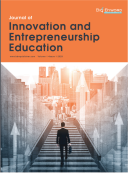Abstract
This study was conducted to investigate the effects of general English class instructional pedagogy through movies on college students’ cognitive and affective satisfaction. For the purposes of this study, conventional pedagogy (language driven) and film pedagogy (content driven) were employed with 146 college students enrolled in the Movie English Liberal Arts class at Kookmin university in Seoul. To find out the pure causal effects of conventional and film pedagogy on students’ cognitive and affective satisfaction, other confounding co-variants were included in the research model and statistically controlled. The AMOS software was applied to analyze structural relationships based on participants’ questionnaire data. The main research findings are as follows: first, conventional pedagogy and film pedagogy had statistically significant effects on students’ cognitive satisfaction; second, conventional pedagogy and film pedagogy had statistically significant effects on students’ affective satisfaction; third, in both cognitive and affective satisfaction, film pedagogy had larger standardized path coefficients than conventional pedagogy. These results suggest that, in terms of its role as an instructional method, not only did Movie English help students improve their English knowledge but also their confidence. In addition, to teach English through movies, film pedagogy integrated with conventional pedagogy is necessary. Moreover, pedagogical implications and future studies were discussed.
References
Ryu D-H, 2015, Revisiting the Integration of Content and Language: With a Focus on Free Translation Activities. STEM Journal, 16(3): 67–86. https://doi.org/10.16875/stem.2015.16.3.67
Met M, 1999, Content-based Instruction: Defining Terms, Making Decisions (NFLC Reports), http://www.carla.umn.edu/cobaltt/modules/principles/decisions.html
Lee J, 2010, Why Movie Novels? STEM Journal, 11(2): 141–161. https://doi.org/10.16875/stem.2010.11.2.141
Yum M-S, Kahng Y-K, 2007, An Effect of Using Movies in English on Vocabulary Power and Interest in Primary English Education. STEM Journal, 8(2): 55–82. https://doi.org/10.16875/stem.2007.8.2.55
Rhee E, 2011, Creative Music Education Plan Utilizing Visual Media: Focusing on Storytelling the Movie, Jeon Woo Chi. Korean Journal of Culture and Arts Education Studies, 6(2): 161–180. https://doi.org/10.15815/kjcaes.2011.6.2.161
You Y-A, 2000, Today and Tomorrow of Screen English. STEM Journal, 1: 97–126.
Seo E-M, 2018, Cinema-based English Learning: Focusing on About Time. STEM Journal, 19(3): 45–64. https://doi.org/10.16875/stem.2018.19.3.45
Suh K, 2016, In the Web 2.0 Era, Studies on Teaching Methods of English Poetry Through Digital DIY (do-it-yourself) Building. Studies in English Language & Literature, 42(2): 141–159. https://doi.org/10.21559/aellk.2016.42.2.008
Ryu Y-A, 2010, The Theoretical Validity and Educational Basis of Using Movies in Language Education. STEM Journal, 11(1): 103–128. https://doi.org/10.16875/stem.2010.11.1.103
Lipiner M, 2011, Lights, Camera, Lesson: Teaching Literacy Through Film. E-Learning and Digital Media, 8(4): 375–396.
Kim D, 2019a, Teaching English Utilizing the Movie The Parent Trap. Secondary English Education, 12(1): 223–242. https://doi.org/10.20487/kasee.12.1.201902.223
Park Y, 2014, Teaching English with the Use of Movie Speeches. STEM Journal, 15(1): 57–81. https://doi.org/10.16875/stem.2014.15.1.57
Lee S-H, Kang M-K, 2019, A Study on the Role of Culture in the Animation, Zootopia: Based on Pop-culture References and Easter Eggs. STEM Journal, 20(3): 71–90. https://doi.org/10.16875/stem.2019.20.3.71
Bacon S, 1992, Phases of Listening to Authentic Input in Spanish: A Descriptive Study. Foreign Language Annals, 25(4): 317–333. https://doi.org/10.1111/j.1944-9720.1992.tb00552.x
Giroux HA, 2002, Breaking into the Movies: Film and the Culture of Politics. Blackwell, Malden.
Inage I, Lawn E, Lawn M, 2013, An Analysis of Student Motivation in an ESL Classroom by using a Movie and Reader’s Theatre Styled Assignments: Based on Student Feedback. Bulletin of Faculty of Education, Nagasaki University: Curriculum and Teaching, 53: 61–63.
Brown D, 2001, Teaching by Principles: An Interactive Approach to Language Pedagogy. Longman, New York City.
Garza T, 1991. Evaluating the Use of Captioned Video Materials in Advanced Foreign Language Learning. Foreign Language Annals, 24(3): 239–258. https://doi.org/10.1111/j.1944-9720.1991.tb00469.x
Lonergan J, 1995, Video in Language Teaching. Cambridge University Press, New York City.
Stempleski S, Tomalin B, 1990, Video in Action, Prentice Hall, Englewood Cliffs.
Voller P, Widdows S, 1993, Feature Films as Text: A Framework for Classroom Use. ELT Journal, 47(4): 342–353.
Honebein PC, (eds) 1996, Seven Goals for the Design of Constructivist Learning Environments. In Constructivist Learning Environments: Case Studies in Instructional Design, Educational Technology, Englewood Cliffs, 11–24.
Kim H-J, 2018, Using Animation for Effective Grammar-focused Learning: With Reference to a Situation-based Approach using Context. STEM Journal, 19(1): 21–41. https://doi.org/10.16875/stem.2018.19.21
Rho Y-A, 2018, A Study on the Characteristics of Vocabulary Types in the Movie The Holiday. STEM Journal, 19(1): 43–64. https://doi.org/10.16875/stem.2018.19.1.43
Ryu D, 2019, A Study Suggesting an Effective Way to Teach Multi-word Units Through Movies: With Reference to Now You See Me 2. STEM Journal, 20(1): 23–44. https://doi.org/10.16875/stem.2019.20.1.23
Seo J-Y, 2014, Routines Revisited: Based on the American TV Drama, Desperate Housewives. STEM Journal, 15(1): 83–104. https://doi.org/10.16875/stem.2014.15.1.83
Im M, 2017, A Study on the Feasibility of Applying Noticing Activities in the EFL Classroom: With Reference to the American TV Sitcom The Office. STEM Journal, 18(1): 65–83. https://doi.org/10.16875/stem.2017.18.1.65
Lee J-H, 2019, Suggestions for Transmedia-based Classroom Activities: Using Harry Potter and the Sorcerer’s Stone. STEM Journal, 20(3): 91–114. https://doi.org/10.16875/stem.2019.20.3.91
Kim D, 2019b, Teaching English Through the Analysis of the Movie The Proposal. Teacher Education Research, 58(2): 171–182. https://doi.org/10.15812/ter.58.2.201906.171
Lee S, Cho G, 2019, The Effects of Creativity Enhancement Program using Movies on Everyday Creativity of College Students. The Journal of Yeolin Education, 27(4): 25–50. https://doi.org/10.18230/tjye.2019.27.4.25
Park J-E, 2011, Using Movies in University-level Liberal English Education. Studies in English Language & Literature, 37(2): 225–247. https://doi.org/10.21559/aellk.2011.37.2.012
Lee YJ, Lee J, 2012, Why Movies? Revisiting the Policy of Supporting General English Education: Using Good Will Hunting. STEM Journal, 13(3): 89–103. https://doi.org/10.16875/stem.2012.13.3.89
Park H, Jeon H, 2019, An Empirical Approach to the Study of the Pragmatic Competence Through Movies. Journal of Learner-Centered Curriculum and Instruction, 19(12): 1111–1133. https://doi.org/10.22251/jlcci.2019.19.12.1111
Ok J-S, 2012, An Effective Screen English Teaching Model: With an Emphasis on Teaching English Pronunciations and American Cultures in Prime Love. STEM Journal, 13(1): 105–127. https://doi.org/10.16875/stem.2012.13.1.105
Joe J-O, 2017, A Study on an Approach to Communicative English Grammar Instruction using Movies. Korean Journal of General Education, 11(2): 689–714.
Kim H, 2007, Exploring the Effects of Family Background, School Education, and Private Tutoring on High School Students’ Achievement in Korea. The Journal of Educational Administration, 25(4): 485–508.
Lord P, Miller C, (Directors), 2009, Cloudy with a chance of meatballs [Motion picture]. Sony Pictures Animation, United States.
